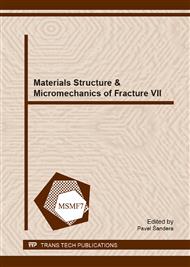p.291
p.295
p.301
p.307
p.313
p.317
p.321
p.325
p.329
Deformation Mechanisms in Ultrafine-Grained Zn at Different Strain Rates and Temperatures
Abstract:
The deformation mechanisms in ultrafine-grained hexagonal close packed Zn were investigated at different strain rates and temperatures. The influence of grain size on the deformation mechanisms was revealed by comparing the results obtained on ultrafine-grained and coarse-grained Zn. It was found that for coarse-grained Zn at room temperature and strain rates lower than 10-2 s-1 twinning contributed to plasticity besides dislocation activity. For strain rates higher than 103 s-1 the plasticity in coarse-grained Zn was controlled by dislocation drag. In ultrafine-grained Zn the relatively large dislocation density (~1014 m-2) and the small grain size (~250 nm) limit the dislocation velocity yielding the lack of dislocation drag effects up to 104 s-1. For ultrafine-grained Zn, twinning was not observed in the entire strain rate range due to its very small grain size. During room temperature compression at strain rates higher than 0.35 s-1 and in high temperature creep deformation of ultrafine-grained Zn besides prismatic and pyramidal <c+a> dislocations observed in the initial state, <a>-type basal and pyramidal dislocations as well as other <c+a>-type pyramidal dislocations were formed.
Info:
Periodical:
Pages:
313-316
Citation:
Online since:
November 2013
Authors:
Price:
Сopyright:
© 2014 Trans Tech Publications Ltd. All Rights Reserved
Share:
Citation:


